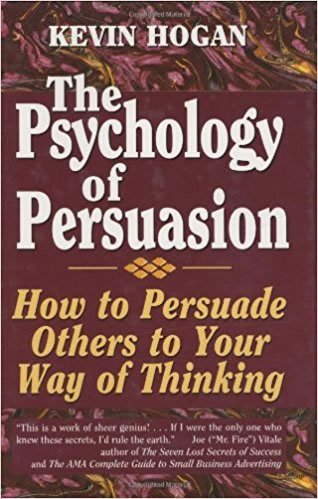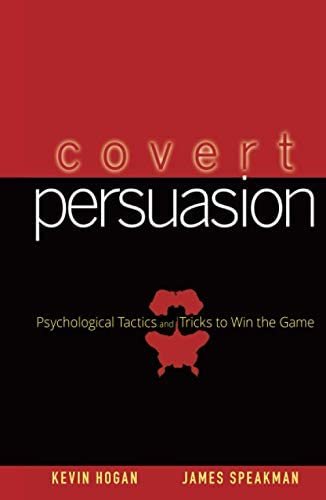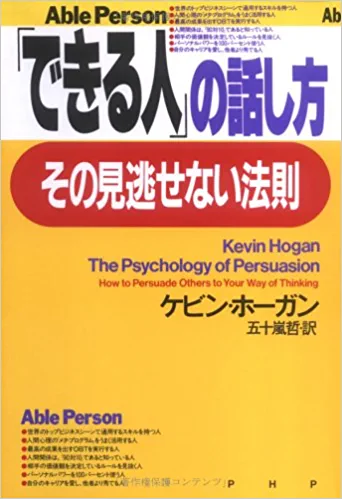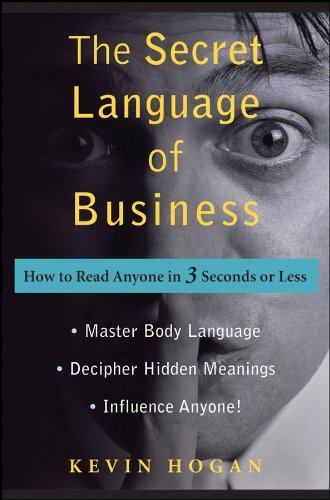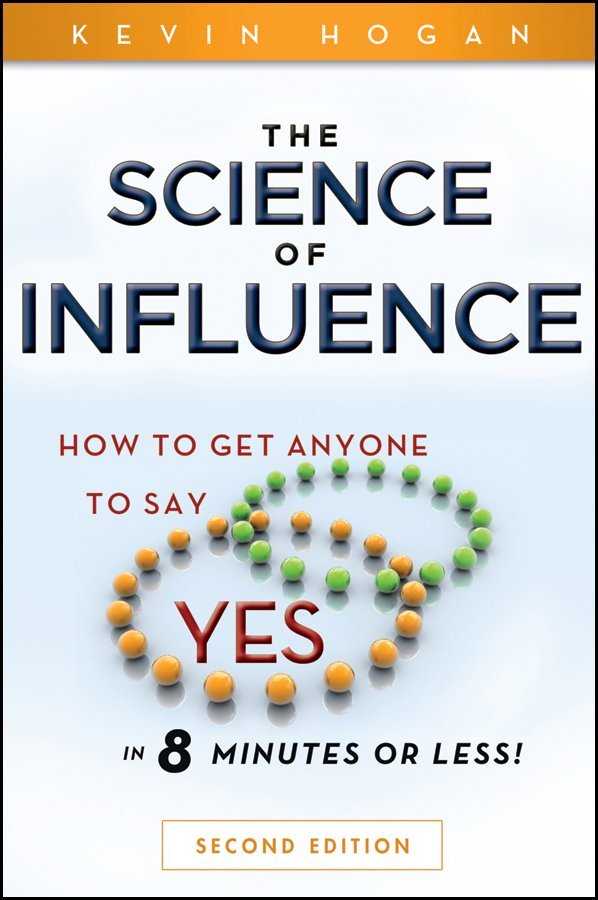…Your New Brain

by Kevin Hogan
Part of your brain is in a constant process of “goal achievement.”
Don’t get too excited. The passive goal guidance system isn’t what they told you it was. To be sure it has some benefits, but for the most part it stops you from ever achieving anything you might call success.
They wanted you to believe that your brain was like a heat seeking missile that hit whatever target you wanted. And then, for you (and everyone else) the idea just didn’t work. It did feel good believing though, didn’t it?
Let’s look at what is happening in the brain right now and how it can be altered to get you more of what you want or need in life.

All day long your nonconscious brain drives your body to get you what you absolutely need based on past programming. Dozens of directives, perhaps hundreds are acquired every single day.
Your nonconscious directives are predictably successful. You pretty much get everything your nonconscious moves you toward.
You do get to the restroom. You rob the cookie jar without your conscious mind remembering the hand entry or acquisition of the cookie.
You successfully react to texts, messages, email and delete spam before and after answering emails…and remember almost none of it…
(Can you name five pieces of spam that you deleted today out of the hundreds you saw?)
It’s not an easy task.
Your brain grabs what it wants at the store…and many of those acquisitions are instantaneous goal/achievement moments…impulses.
You return home and your brain finds as many ways as possible to do nothing else beyond using the restroom, acquiring food and finding comfort for the remainder of the day.
In fact, ANYTHING you do beyond these nonconscious goals, CAUSES STRESS and is perceived by your nonconcsious goal seeking system as a BAD thing. That stress triggers conscious awareness of your discomfort.
Even THINKING or SPEAKING of goals creates problems. Your nonconscious behavioral cues (body language of which you are unaware) triggers almost guaranteed negative emotions in anyone in your presence. This creates something on the scale of minor irritation to outright hostility in others around you. And that of course creates triggers in others that you now pick up on.
The looping behaviors that happen next are a mess. They are not productive to goal acquisition or good relationships.
Getting your conscious mind to achieve any goal that requires more than 24 hours to acquire…is typically destined for failure. There are simply too many external and internal stop signs to ever achieve real goals that matter…those that require discomfort.

There are lots of “secrets” to goal achievement. You don’t read about many online and the fact is marketers don’t want you to know the real story…which is mostly why I’m going to give you a few of the missing pieces today.
Professional Marketers have the same problems setting their OWN goals but the truly good marketers know one secret that you don’t. You must have one experience as soon as you buy their product. What is it? The answer holds a long held secret of goal targeting and acquisition.
As an example as you read along consider this:
Anything you want to be “easy to achieve” requires developing habits where you repeat behaviors over and over. This is very much like the basketball player shooting 100 free throws every morning. I particularly love audio programs because you have the real likelihood of learning redundancy. You’ll listen to it more than once, which is an absolute requirement to get information “drilled in.” Once something is drilled in from repetition the nonconscious can file it in the Passive Goal Guidance System.
How are the Brain’s Subroutines Created?
Remember this for the rest of this article and the rest of your life: Redundancy is what creates the brain’s subroutines for a given set of inputs.
I can’t tell you how many people I know who (for example) own copywriting programs that have no website or business.
Writing copy is what I have to write for you when I want to tell you about the Decision Point Course that is beginning soon online.
So many people buy courses on how to write copy, create promotional video…it’s remarkable. What’s ironic is they don’t market or promote anything…they aren’t in business. This is similar to the guy who has a website but has no business merchant account to accept credit cards.
It’s like buying an oven that cooks pizzas before buying the actual building where you’ll have your pizza shop. It’s interesting…and teaches you and I a great deal about goal acquisition.
The Comfortable Middle

PEOPLE LIKE TO BEGIN in “the middle.”
The person at home is desperate to begin in the “comfortable middle.”
The middle is the place where all the truly HARD work has been DONE and is BEHIND the individual.
When told well… listening to a story which begins in “the middle” can be “illusively” inspiring because you don’t have to go through Act One, which is The Beginning. The beginning is the most difficult piece of any business equation.
Write This Down because…Here’s the Point:
The Beginning of Anything Means there is a LONG way to go…
Example: Less than 20 people per day are coming to your website, or, the person has no website. Or, the person has no business. Or, the person has not created the product yet. Or, the person has not connected with affiliates. (Don’t start sentences with the word “or” by the way or the English Teachers will freak out…)
Example: The person at the beginning has not written the first chapters of the book….because it’s at the beginning.
The Tough (and Glossed Over) Beginning
The Beginning is tough because it’s all unfamiliar. Think about the first time you built a website. It took a month. Today? You can do it in a day….or less. With WordPress? You can do it in 3 hours.
The stress of the beginning isn’t that everything is always hard every day. Sometimes it is. But just as often it’s about being stuck for a day on what turns out to need a wildly simple 1-minute solution.
Internet Marketers, for example, hate to teach the beginning.
There is no “fast way” to get someone to be competent at anything without them actually doing it themselves first…usually a number of times.
The gurus haven’t built a website in 5 years. Everything begins in the MIDDLE for the guru.
The Middle?
Ah…this is where the marketer is at home. This is where the story sounds, feels and intuitively hits home with the reader of a salesletter or mail piece…any advertisement.
They have a mailing list. They have sold products before. They have done product launches. Or in the example of an author? The middle is when the book is completed and then you are to the point where you are going to begin selling the book to a publisher.
Starting in “the middle” tricks the brain to “believe” that this is going to be pretty easy. This is requisite for the marketer and the buyer, too…
The person listening to the presentation that begins in the “middle” doesn’t have to think about writing the book, opening the store, putting up the money on the franchise or whatever. The middle assumes all the problems have been worked out and now it’s all about the smart stuff…in this case…marketing. And there is some truth to this.
Marketing is much easier than building a website….unless, of course, you’ve just finished a month or two of learning how to build a website, use Tik Tok, master Instagram, figure out how to use Facebook Ads, blog, do video, etc. In that case the person doesn’t want to learn to market or anything else because they are wiped out from learning how to get the website working and make it user friendly.
Obviously, it’s a lot easier to train someone marketing, assuming all the grunt work has been done.
Unfortunately, the stuff at the beginning typically hasn’t been done…or started…or learned or even imagined.
This is why the Short Term Pragmatic Marketer wants to optimize his income by selling an excellent product to anyone – regardless of their level of preparedness.
There’s nothing absolutely unethical about this, but it pushes the envelope further than I find comfortable.
Nevertheless as soon as you understand this one concept of how the most effective marketers build wealth rapidly, your entire paradigm of life might shift.
Watch…The Nerd and the Super Model
The Nerd and the Supermodel …
Every Nerd wants the Super Model.
But wait…everyone wants the Super Model… (Now set that thought aside for just a moment.)
The Nerd and the Supermodel
Here is what starting in the middle REALLY MEANS. It’s like a nerdy 15-year-old guy asking a 21-year-old supermodel gal out on a date and he needs an instruction manual.
The easiest sale to be made in the world is selling the product that shows how to get the 21-year-old super model to go out with you. Why? Because every guy wants that.
But…when you are 15 or 16, you aren’t prepared. You have no resources. No bank account. You aren’t on her radar. The pragmatist has skipped past the guy’s age and preparedness. He’s gone straight to the cool part which is past growing a wallet, looking good and having the required social status.
There’s nothing remotely bad about selling knowledge. It’s a cool product. But it’s only seriously optimal information for a narrow group of guys.
I’ve been sharing “cutting-edge” information about influence, life optimization and wealth-growing knowledge products for a long time.
I rarely repeat anything. My clients and customers pick on me mercilessly if I repeat a story on audio 1 of product Z in 2012 and then a new course in 2022. (I have no concordance…someone has an opportunity here!)
Each program generally assumes that the person is basically at Square One. From my friends perspective…I have made the mistake of having missed out on one extra digit of income each year. Not insignificant. It never dawned on me that people would consider the purchasing of the product as goal progress.

Ever…
I see so many programs on the market that are not remotely workable for anyone who hasn’t already begun. Yet these programs are often the best selling programs on the market in my world.
DAMN.
Think about it.
Goal Progress?
The gurus figured out something that hadn’t even struck me.
My paradigm is so skewed toward rational productivity that it woke me up like a shock.
The act of reading the salesletter.
The act of contemplating buying the program.
The act of opening the program and putting it on the desk.
The act of putting the first DVD in and watching it and finding out how much the guru just did in the last launch…
…those ACTS are all goal progress. It never dawned on me.
Not for a second.
When this hit me one day, I felt like a rookie.
I was waaaaaaaay too many steps ahead as to where goal progress first becomes an issue.
I never knew a marketer who knew about the psychological concept of goal progress…but then I’d never thought about the process of buying a product as a trigger for goal progress to be experienced…and thus complete in and of itself.
Here’s what happens and what it causes to happen next…which is not such a good thing..
See “Goal Progress,” is *not* a good thing…not at all…
Goal Progress, your Unconscious Self, and flipping this for success …
Where Goal Progress Begins
Goal progress is where the nonconscious part of your brain “interprets and instantly reacts” to the input that you have made ENOUGH PROGRESS toward your goal to STOP WORKING on THAT GOAL and SWITCH to a REWARD of some kind.
Read that one more time. It’s huge.
Secondarily, progress toward one nonconscious goal can be made, and then the brain switches to a different working goal instead of a reward.
You are dieting. You lose the 10 pounds you wanted to lose. Your brain switches immediately to cleaning the house or fixing the car. The diet is done. You gain 5 pounds back in two weeks because your brain no longer pursued it. The new routines didn’t get drilled down deep enough.
Goal progress is experienced and the person feels GOOD about having made the purchase. They hear the stories and they believe that is where they are going or at the least they can imagine it happening and therefore, at THAT POINT, the brain shuts down on that goal and switches to reward!
The Passive Goal Guidance System
…let’s go back to “goal progress” and create a fundamental understanding of Goal Progress.
I’ve taught about the Passive Goal Guidance System since the moniker was first coined by its discoverer about 4 years ago.
But I clearly started my thinking about my own marketing strategy in a somewhat naive fashion. And to find this out after all these years of doing pretty well…
So, let’s go back and get this down to where you have a thorough and complete comprehension of the PGGS and Goal Progress.
The concept is easy. The ability to make applications takes a few extra steps.
In the old days…20 years ago, most scientists and most motivation experts believed that the closer a person got to a goal, the more motivation they experienced in getting it.
In working with salespeople and business owners, corporations….for quite some time, I knew that there might be lab settings where that was true, but the notion in the real world never matched what I observed.
My opinion was simple: The Scientists were wrong because they were assuming people thought like scientists and made logical decisions based on factual information….and that is just not true.
Was I right? Could a cadre of social scientists be wrong?! What did it mean?
A Prime Example? …
Being an author is a prime example.
Most people believe writing a book is a goal.
It’s really about 1/3 of a goal.
Writing a book is relatively easy.
You sit.
You write. (A lot of people get this far)
You edit. (A lot of people get this far.)
You have a manuscript. (The number of people here tapers off before this is completed.)
But assuming the manuscript is finished, nothing of significance has really happened yet.
Yep.
You wrote for 9 months, and the fact is that you have accomplished zip.
The book now needs to be sold to a publisher. (Most people’s notion of self publishing is going to net them $500 for their 9 months of work. To effectively self publish, and it can be done, requires a pretty shrewdly implemented business plan to generate book sales.)
The manuscript…is…nice. It’s cute, like a baby.
The manuscript needs to be sold and THAT means the person has a LOT of work ahead of them. This is an entirely different world than writing a book. Writing requires no “work,” and work is constituted as actions that generate revenue…i.e. marketing and sales.
The process of selling a manuscript without a dramatic knowledge of publishing is extremely difficult. Most people believe a publisher will buy “a good book” and “sell it.” That isn’t what happens, though.
How do you get published in real life?
The publisher finds out how many sales you’ll be making, and for 95% of all first time authors, that is where the decision to buy the book will be made. Got 5,000 copies they believe will be sold and they can see your plan and it adds up to an easy 5,000? You’ll sell the book to most publishers. But 90% of authors don’t have the current capacity to do that…it might be more, but I’ll say 90% for now.
After you’re done writing the book, it is tough to self persuade the brain that nothing has really happened in the real world yet.
Imagining that someone can persuade their brain to let them continue the process of getting published and having a hot selling book, let’s imagine that they are able to develop a mailing list of fans or one incredible strategy that is big enough to generate book sales. They put it together in a proposal and the publisher says, “yes.”
Goal Progress has been made by a definable yardstick and the brain “knows it.”
NOW the author’s brain REALLY FEELS DONE.
But, nothing could be further from the truth.
Just Gettin’ Started
All that has happened is a manuscript has been purchased.
The brain believes it’s now time to party or go do ANYTHING but something related to “the book.”
The brain needs to be convinced that there is yet another series of projects ahead.
Now the author must go forth into the world and sell her book.
And THAT IS REAL WORK.
The difference between marketing and sales, and everything else, is REJECTION.
Where rejection can happen, the brain doesn’t want to go. It is here that the brain will experience Goal Progress BEFORE REJECTION POINTS.
If an author doesn’t finish a book, no one knows it.
If an author is turned down by a publisher, the author has become a lot more than vulnerable. They are exposed and have been told, “no.”
You have no idea how many unpublished manuscripts are out there because people don’t know how to get a book published.
Published authors who are offered a second contract, perhaps more so than the vast majority of people, will have no problem with making requests, asking for dates, negotiating deals. They are likely the most capable humans because in the face of rejection at every turn they persist. In spite of NUMEROUS Goal Progress points, points where “normal humans” would switch gears, they “fight themselves” and win. They CONTINUE and get published and sell books….a lot of them…past a lot more rejection and difficulties.
The trigger of achieving nonconscious Goal Progress is almost always met with the body following the nonconscious into other nonproductive activity that FEELS LIKE it is important.
Why does everyone always finish cutting their lawn? …
Why Does Everyone Always Finish Cutting Their Lawn?
I’ve shared this metaphor in the past at Influence: Boot Camp. And I confess I wrote about it somewhere…
Let me show you how this works in real life:
How often do you see a half cut lawn?

You know when the person has cut…half the yard and they called it a day, went in the house and left the yard half cut and half uncut to be done perhaps tomorrow?
The fact is that over 98% of all lawns are COMPLETELY cut when the individual takes the task on. Why? Because EVERYONE SEES the Progress. The only thing that looks worse than a lawn out of control is a lawn that is half out of control and half cut.
BUT…
If no one else observed the 1/2 cut lawn, everything would be completely different.
The lawn would go 1/2 cut and the project picked up tomorrow.
Evidence?
How often does an individual set out and vacuum the ENTIRE HOUSE? Most people will vacuum a room or two and leave the rest for another day. A guess? 80% of the time, the person leaves a partially vacuumed house. Few people vacuum an entire house even though it takes about the same amount of time as cutting the lawn.
Why?
Because no one else in the neighborhood sees the un-vacuumed part of the house.
When there is no one watching, no one to be accountable to, the brain will STOP when its Goal Progress mechanism is triggered and something else is pursued.
Writing a book?
Putting up a website?
People quit as soon as the manuscript is done and as soon as the website is functional.
Why?
Because the person experienced Goal Progress.
Specifically?
When you set out to write a book, you had this picture: “I’ll sit here at the computer for the next few months and finish the book and my brain nonconsciously knows that mean it sees a cool cover on a book in the future, but what it really means is the manuscript is completed.”
Complete Manuscript = Locked Down Goal Progress
Very few manuscripts that are written ever make it in perfect bound book form to 5000 buyers.
They saw “finishing the book” as the end result. Unfortunately they didn’t make the correct assessment of what that meant.
Sputters of Goal Progress
If you want to personally overcome the sputters of Goal Progress, you have to begin with setting up a model or template of what THE GOAL really is.
Then you tell yourself you will pursue something and everything else when THE GOAL is COMPLETE.
Specifically in the case of the book?
You make your goal a simple timeline.
- Develop the idea and story/content. October 2016
- Research and begin writing.
- Write all chapters.
- Contact authors for endorsements. December 2016
- Develop marketing plan complete with specifics broken down to minutiae. January 2017
- Sell book to Publisher. (before September 2017)
- Grow marketing plan and prepare with publicist for Opening Day (August 2017)
- Aggressively do 3 big things every day that will generate book sales or you add another big thing that will until book sales are generated.
GOAL: August 2017, You are 60 days into book selling and the goal is met. You have performed 180 specific tasks that SOLD books (past tense).
You now have a Time Line and a Task Line. This is a goal and a goal is not something “to be achieved.” This is not to be achieved. It IS WHAT WILL HAPPEN.
The difference is enormous.
You aren’t making a “proposal,” or a “suggestion” or “hoping something happens,” or will get it done if “humanly possible.” That’s what happens at a job.
So, what’s the BEST way to measure progress? …
Key: Measure Progress from the End
You aren’t going to hope to raise a child. You are RAISING THE CHILD and when they turn 18 you boot them from the nest (so as to not give back all the progress you made!).
And ALL TASKS are measured from THE GOAL *not* from July 10, 2011.
NEVER measure from where you begin.

You must train your brain to measure from THE END.
You must measure from THE END.
In almost all cases, if you measure how far you have “come” you will run into MORE Goal Progress sputters and quit.
If you measure “how far to go” and see each task as one step closer, your motivation will INCREASE as you come closer to the goal.
KEY POINT: Sadly, 90% of people think about “how much I have already done,” and not “what there is remaining.”
Fascinating research on how to measure goal progress? …
Research on Goal Progress
Here is an example:
At the end of an experiment unrelated to Goal Progress, students were paid $15 in an envelope for their participation. There was also a note in the envelope with information about a charity project.
Students were told to leave something for the charity. Each student’s note indicated the charity was going to raise $300. There were six different notes a student could read. The first three showed “current progress toward goal.”
How much of the $15 did participants leave, on average, for the charity when given the following messages?
1) The Charity had already raised $55
2) The Charity had already raised $145
3 The Charity had already raised $245
The second group of three showed “money still to be collected.”
4) The Charity had $245 to go.
5) The Charity had $145 to go.
6) The Charity had $55 to go.
In the money still to be collected group, here was what the average donations turned out be
4) The Charity had $245 to go? $1.45
5) The Charity had $145 to go? $1.10
6) The Charity had $55 to go? $2.86
As we’ve been discussing today, that makes sense.
The goal is almost there and the big bucks roll in at the end from the participants.
When framed as the money already collected?
1) The Charity had already raised $55? $2.68
2) The Charity had already raised $145? $1.12
3 The Charity had already raised $245? $1.50
For today, the take home is that when the charity was early on and the students who got that message knew they had only collected $55 – and wanted to help in a greater way.
DO NOTICE that there is an interesting twist here: In both cases, the students donated the least when the note indicated they’d come half way or had half way to go. That’s a different issue and I’ll talk about that next week with you.
It’s an important nuance that I discovered in Psychological Science 22: 607 originally published online 7 April 2011; Andrea Bonezzi, C. Miguel Brendl and Matteo De Angelis Stuck in the Middle : The Psychophysics of Goal Pursuit.
Next week? Part Two. Why the middle is where everything goes to hell…


